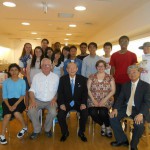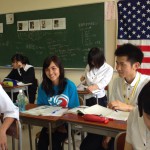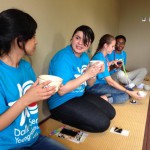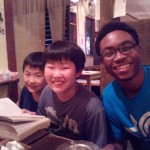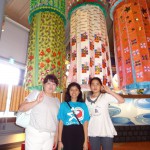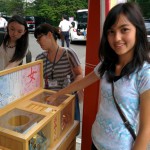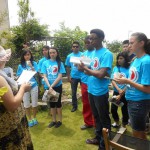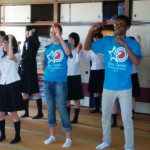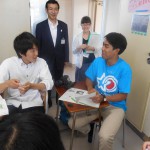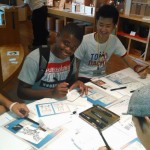TOMODACHI Dallas-Sendai Young Ambassadors Enlightened and Motivated After Sendai Visit

On July 7, 2014, nine participants from the Dallas-Sendai Young Ambassadors Program visited the U.S. Embassy in Tokyo to partake in a roundtable discussion regarding their newfound, shared affinity for Sendai, Miyagi after staying with Japanese host families in the city for one week. This year’s exchange symbolized the program coming full circle; the exchange during the summer of 2013 gave Japanese students from Sendai the opportunity to visit Dallas, Texas for one week, where they engaged in local Texan activities and shared their experiences of March 11, 2011. The reciprocal nature of the program embodies the spirit of cross-cultural understanding that is being fostered between the youths of the U.S. and Japan after the earthquake and tsunami. As a result of this program, mutual compassion and cultural sensitivity has been realized.
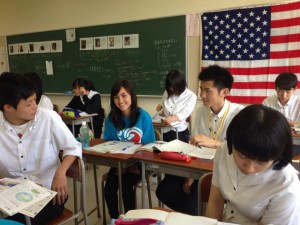
The students each gave short speeches that summarized their individual experiences in Sendai that shaped their perspectives of Japan. Led by two chaperones and a Japanese interpreter, the students were able to fully immerse themselves in Sendai’s culture and environment through their daily activities. Highlights that they spoke of included the visits to the Sendai City Museum, Seiryo High School, the Mori-no-sato Retirement Home, and a special meeting with the Sendai mayor at the City Hall. According to the students, the host families they stayed with along with the people they met were eager to teach them about Japan as well as learn firsthand about the customs of America. “They wanted to share their culture with us, the way we wanted to share our culture with them,” Nevya Tomasa Hernandez said.
The discussion was lively and humorous, as the participants fondly recalled their memories in Miyagi prefecture. They marveled at certain cultural nuances unique to Japan, such as removing shoes before entering homes and slurping noodles. Of particular popularity among the exchange students were the communal bathhouses. “I think that [for me] one of the greatest and eye-opening experiences was going to the communal bath. Now that was something,” Esmeralda Crystal Alejo said. The students also emphasized that although it was for a short time, they grew very close with their host families. “I really enjoyed Sendai’s culture and atmosphere. However, my favorite part was being able to stay with my host family. My host family was the best. I really loved them and I will never forget them,” Leslie Berry said. Pauleen Speegle, another participant, agreed with just as much enthusiasm. “Japan’s host families were amazing! In only 5 short days with them I already [felt] like they are my family and I miss them so much,” she shared.
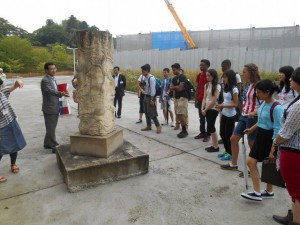 However, a consistent theme of the emotional implications of the March 11 disaster threaded in and out of the discussion. Many students repeated several times how emotionally moved they were upon visiting the ruined sites. One student, Sameer Kareem Khoja, mentioned how shocked he felt when he discovered that the concrete squares that dotted the landscape were foundations of homes. During his speech, he expressed that though he witnessed the hardship and tragedy of the area, he was able to find faith: During one of the visits in the affected area, he vividly remembered visiting a playground that sat atop a hill. This playground served as a point of refuge for many children during the disaster. As he stood there and observed all that was around him, he recalled that he felt as if he had entered a safe haven, and that to him the site represented hope.
However, a consistent theme of the emotional implications of the March 11 disaster threaded in and out of the discussion. Many students repeated several times how emotionally moved they were upon visiting the ruined sites. One student, Sameer Kareem Khoja, mentioned how shocked he felt when he discovered that the concrete squares that dotted the landscape were foundations of homes. During his speech, he expressed that though he witnessed the hardship and tragedy of the area, he was able to find faith: During one of the visits in the affected area, he vividly remembered visiting a playground that sat atop a hill. This playground served as a point of refuge for many children during the disaster. As he stood there and observed all that was around him, he recalled that he felt as if he had entered a safe haven, and that to him the site represented hope.
With extraordinary sincere and empathetic human-to-human experiences tucked away safely in their memories, the Dallas exchange students return home to share their bilateral journey with the wider world; however, they fervently expressed their desires to return soon to Sendai to visit their host families, and even study at a Japanese university. “I hope to continue [these] friendships for years to come and that we can help unite more people as we’ve been united,” Tomasa Hernandez said.
- For more information on this program, click here

This program is funded by TOMODACHI’s Fund for Exchanges through generous contributions from Toyota Motor Corporation, Mitsubishi Corporation, and Hitachi, Ltd.

